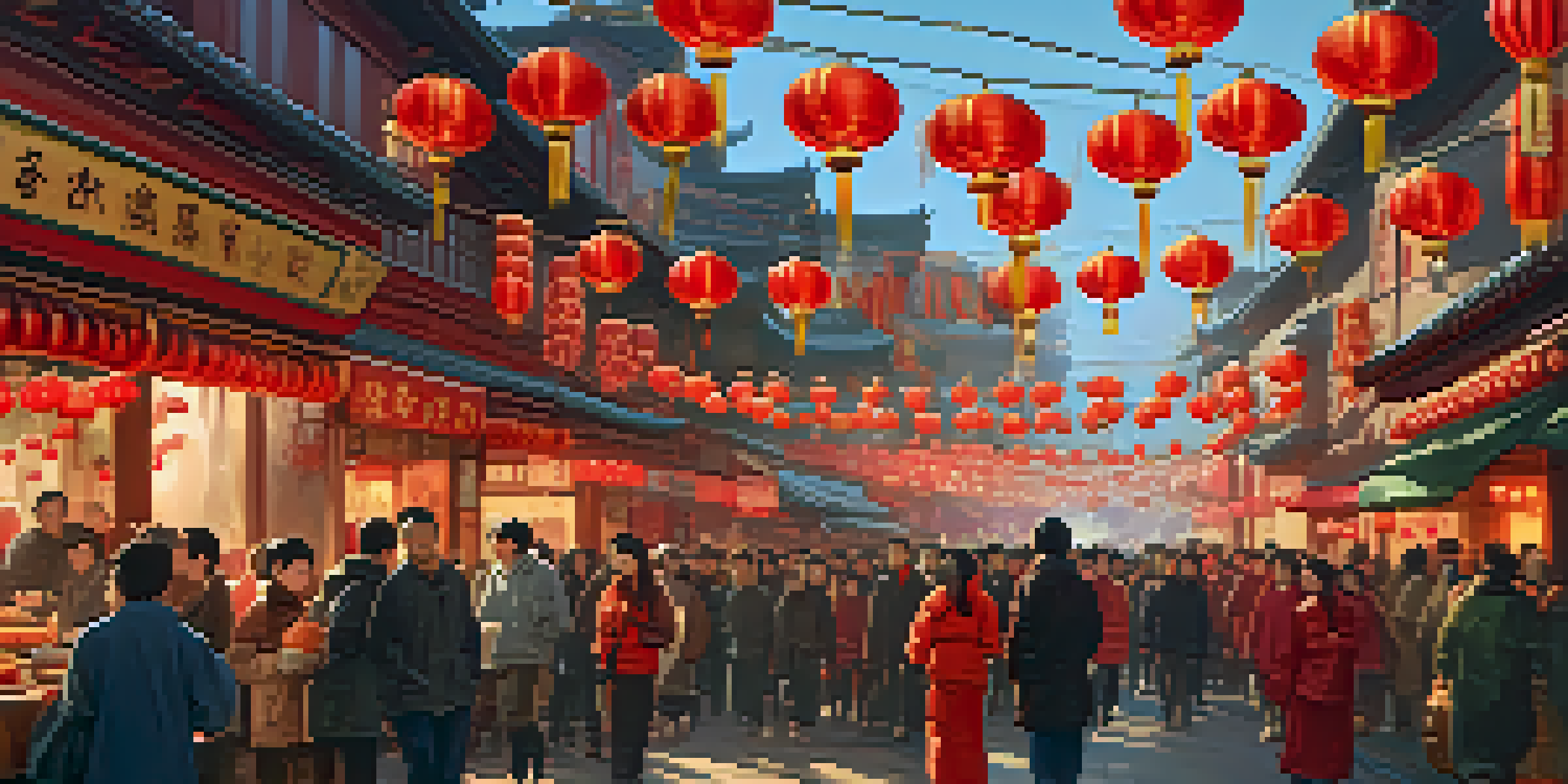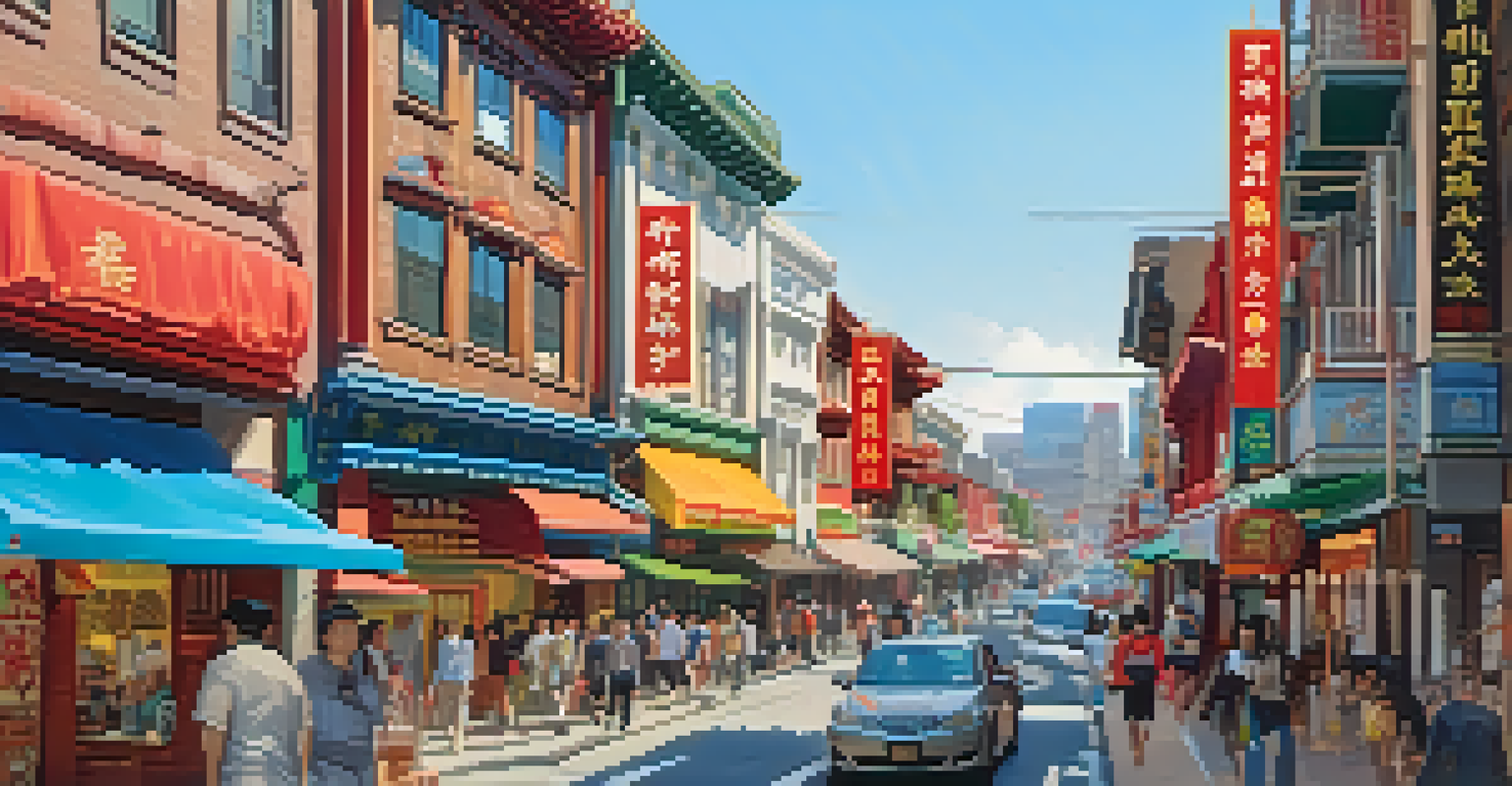Chinatown's Evolution: From Settlement to Tourist Destination

The Origins of Chinatown: A Community Takes Root
Chinatown's story begins in the mid-19th century when Chinese immigrants arrived in search of better opportunities during the Gold Rush. Settling in urban areas, they formed tight-knit communities, often facing discrimination and hardship. These early settlers built a foundation for what would become a vibrant cultural enclave, contributing to the local economy and enriching the social fabric of their new homes.
Chinatowns are a reminder of the struggles and triumphs of immigrants who created vibrant communities against all odds.
As they established businesses and communal organizations, these immigrants created a sense of belonging amid a foreign landscape. The first Chinatowns emerged in cities like San Francisco and New York, where they found solace in shared language, traditions, and cuisine. This initial settlement phase laid the groundwork for the cultural identity that would flourish in the years to come.
Despite the challenges they encountered, including the Chinese Exclusion Act of 1882, these communities persisted and adapted. They not only preserved their cultural heritage but also began to influence the broader American society, paving the way for future generations.
Cultural Flourishing: The Heartbeat of Chinatown
As the 20th century progressed, Chinatowns evolved into vibrant centers of cultural expression, showcasing traditions through festivals, food, and art. Events like the Lunar New Year celebrations became staple attractions, drawing locals and tourists alike. The colorful parades, dragon dances, and cultural performances highlighted the richness of Chinese heritage, creating a lively atmosphere that captivated visitors.

Restaurants and shops also blossomed, offering authentic Chinese cuisine and unique goods that appealed to a wider audience. Dim sum houses and herbal medicine shops became popular destinations, showcasing the rich culinary and medicinal traditions of Chinese culture. This cultural flourishing not only strengthened community ties but also attracted a diverse array of visitors eager to experience something unique.
Chinatown's Cultural Roots
Chinatown emerged in the mid-19th century as Chinese immigrants established vibrant communities in search of better opportunities.
This vibrant cultural scene transformed Chinatowns into must-visit locations, earning them a reputation as cultural hotspots. They became spaces where people could not only enjoy delicious food but also learn about a rich history and tradition that had been lovingly preserved through generations.
Tourism Boom: Chinatowns as Attractions
With the rise of global tourism in the latter half of the 20th century, Chinatowns began to attract visitors from all corners of the world. Tourists flocked to these neighborhoods, eager to experience the exotic sights, sounds, and flavors that defined them. This influx of visitors helped to establish Chinatown as a vibrant tourist destination, complete with shops, restaurants, and cultural experiences.
Cultural heritage is not just about preserving the past; it's about building a future that honors our roots.
As tourism grew, local businesses adapted to meet the needs of their new clientele, offering guided tours and cultural workshops that provided insights into traditional practices. This shift not only enhanced the visitor experience but also fostered a greater appreciation for the Chinese culture embedded within these neighborhoods. The synergy between tourism and cultural exchange became a defining characteristic of Chinatowns.
However, this tourist boom also came with challenges, as some local residents felt the pressure of commercialization overshadowing their cultural heritage. Balancing the needs of tourists with the preservation of community traditions became a crucial conversation among residents and business owners alike.
Gentrification and Its Impact on Chinatown
In recent years, many Chinatowns have faced the daunting challenges of gentrification, leading to rising rents and shifting demographics. As property values soared, local businesses struggled to keep their doors open, while many long-time residents were forced to relocate. This transformation has raised concerns about the potential loss of cultural identity and community fabric that have defined these neighborhoods for generations.
The influx of upscale restaurants and boutiques often comes at the expense of traditional establishments that have served the community for decades. As the character of Chinatown changes, some residents worry that the original essence, rooted in cultural heritage and community, is fading away. This tension between development and preservation has sparked discussions among community leaders and advocates.
Tourism Boosts Chinatown's Appeal
The rise of global tourism transformed Chinatowns into popular destinations, blending cultural heritage with visitor experiences.
To combat these challenges, efforts are being made to preserve the cultural heritage of Chinatowns. Initiatives aimed at supporting local businesses and advocating for affordable housing are becoming increasingly important as communities seek to maintain their identity amidst the pressures of change.
Chinatown: A Global Phenomenon
Interestingly, the phenomenon of Chinatowns is not unique to the United States. Globally, cities like London, Sydney, and Vancouver have their own Chinatowns, each reflecting unique adaptations to local culture and demographics. These neighborhoods serve as cultural ambassadors, showcasing Chinese traditions while also integrating into the local landscape.
As these global Chinatowns continue to evolve, they share common threads of resilience and cultural pride. They become spaces of connection for Chinese communities around the world, fostering relationships and cultural exchanges that transcend borders. This interconnectedness illustrates the enduring legacy of Chinese migration and community-building.
Moreover, the international appeal of Chinatowns highlights their significance as cultural destinations. They attract not only tourists but also locals who seek to experience the diversity and richness of Chinese culture, showcasing how Chinatowns have become vital components of the cities they inhabit.
Preserving Heritage: Community Efforts and Initiatives
In response to the challenges of gentrification and commercialization, various community organizations are stepping up to preserve Chinatown's heritage. Initiatives focused on cultural education, local business support, and historical preservation are gaining momentum. These efforts aim to ensure that the essence of Chinatown, including its traditions and stories, remains intact for future generations.
One example is the establishment of cultural centers and museums that celebrate the history and contributions of Chinese Americans. These spaces not only educate visitors but also serve as gathering places for community events that reinforce shared identity. By fostering a sense of pride and belonging, these initiatives strengthen the community bond.
Gentrification Challenges Heritage
Many Chinatowns face gentrification, threatening their cultural identity and prompting efforts to preserve their unique heritage.
Additionally, collaborations between local artists, historians, and residents are breathing new life into traditional practices. Through art exhibits, performances, and workshops, the rich tapestry of Chinatown's heritage is showcased, inviting both locals and tourists to engage with its cultural significance.
The Future of Chinatown: A Balancing Act
Looking forward, the future of Chinatown hinges on finding a balance between preservation and progress. By embracing sustainable development practices, communities can ensure that economic growth does not come at the expense of cultural identity. This involves fostering partnerships between local businesses, city planners, and community members to create inclusive environments that honor the past while welcoming new opportunities.
Moreover, continued advocacy for affordable housing and support for local businesses will be vital in maintaining the unique character of Chinatown. Engaging younger generations in cultural practices and community initiatives can also play a crucial role in keeping traditions alive, ensuring that the legacy of Chinatown endures.

Ultimately, Chinatown's evolution is a testament to its resilience and adaptability. As it navigates the complexities of change, it remains a vibrant symbol of cultural heritage and community spirit, inviting everyone to partake in its rich history and future.